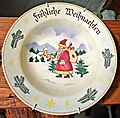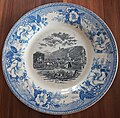Grünstadt earthenware factory
The Grünstadt stoneware factory was an important ceramic company in Grünstadt and emerged from the Frankenthal porcelain manufactory .
history

Johann Nepomuk van Recum (1753–1801) was the last owner of the Frankenthal porcelain factory. Due to a lack of raw materials, he stopped porcelain production in Frankenthal in 1799 and moved with the molds and equipment, as well as some employees, to his home town of Grünstadt, where faience earth or clay from the nearby villages of Asselheim , Lautersheim and Hettenleidelheim was available as raw material. Here in 1801 he founded the Grünstadt earthenware factory. On March 20, 1801, the entrepreneur leased the Leininger Unterhof , annexed by the French state , one of the Grünstadt residential palaces of the Counts of Leiningen, and relocated his work there. It stayed in this place until 1973. Van Recum died in October 1801; his widow Anna Margaretha geb. Jacquemare (1767–1833) continued the business with the children and in 1805 bought Unterhof Castle from the state.
The castle and factory were passed on to the brothers Bernhard Bordollo and Wilhelm Bordollo in 1812 . Her family ran the company for more than 100 years. Even after being converted into an AG in 1900, it retained a share in the company. Originally only faience ceramics were produced, the company gradually switched to the more durable earthenware , which was still exclusively manufactured from 1818. There is evidence that people in Grünstadt also worked with old Frankenthal porcelain molds. a. a paperweight produced here with a naked boy lying down, modeled by Johann Peter Melchior . When King Ludwig I of Bavaria and his wife Therese 1829, the time to Bayern belonging Palatinate traveled, the couple also visited Green City on June 14 1829th Both were received here by Mayor Bernhard Bordollo. A contemporary report states that the monarch inquired about the prosperity of the local earthenware factory and that the “most gracious country mother (queen) deigned to ask for a cup as a sample of the product” . Apparently, Grünstadt stoneware was already a household name for the majesties and they showed a keen interest in it. The factory expanded to become the largest factory in the city and gained national importance. They were exported to the USA and Canada as well as to the Balkans and Turkey. In addition to decorative and utensils, the main products were pipe heads and later clock dials. The company was represented with a wide range of products at the First General German Industrial Exhibition in 1854 , in 1867 it employed around 70 people and was praised for its in the multi-volume state description "Bavaria" Ceramic pipes, in 1873 the pipe range was exhibited as an outstanding German product at the Vienna World Exhibition . Wilhelm Bordollo's grandson Josef Anton Bordollo (1852–1935), mayor and honorary citizen of Grünstadt, was the last family member to leave the company in 1927. At that time, however, he no longer owned the majority of the shares.
In 1934, the ceramics specialist Heinrich Kalau vom Hofe (1903–1988), son of Rear Admiral Eugen Kalau vom Hofe (1856–1935), acquired the Grünstadt stoneware factory. He emigrated to South America in 1939, but remained the owner, returned in 1953 and was company director until 1969. In 1954 the company employed 267 people. In 1957, he made a 20 m wide ceramic advertising mural for the tobacco company Martin Brinkmann AG in Bremen's main train station . Later covered by neon advertising, it was rediscovered and restored as a witness to the 1950s. It is now protected as a cultural monument, today one of the special ornaments of the station hall there and a permanent memorial for the lost ceramic production in Grünstadt. A specialty in the region were the Christmas and Easter plates made there in the 1940s and 1950s; For many people from the Palatinate, who found their St. Nicholas editions and Easter nests in it as children, an unforgettable memory. After a boom in the 1950s and early 1960s, sales fell significantly; Bankruptcy proceedings were opened on February 25, 1969, and in 1971 the previous company premises (Unterhof Castle with factory extensions) were sold to the city of Grünstadt.
On April 1, 1973 Senator Otmar Mayer, a businessman in Frankenthal, bought the company; At the end of the year she moved to her new domicile, Obersülzer Str. 45. Mainly only decorative tiles and andesite insulation panels were produced. In 1978 the company had 8 employees and went bankrupt at the end of the year. On August 5, 1980, the company closed down after almost 180 years of production.
The museum in the old town hall Grünstadt has an extensive collection and exhibition of Grünstadt earthenware products.
Labeling of goods
In the course of the company's long history, the goods were marked with various embossed and imprinted stamps. The best-known symbols were the green and blue round stamps with a grape hanger, which were in use between 1930 and 1953.
literature
- Altertumsverein Grünstadt : Steingutfabrik Grünstadt , Publications, Issue No. 2, 1985
- August Stoehr: German faience and German earthenware: a manual for collectors and enthusiasts , 1920, p. 326
- The faience and earthenware factory van Recum and Bordollo in Grünstadt , in: Pfälzische Heimatblätter , 1959, year 7, no. 9, pp. 70–72
- Hans Fenske, Joachim Kermann, Karl Scherer: The Palatinate and the Revolution 1848/49 , Volume 2, p. 361, Institute for Palatinate History and Folklore, 2000, ISBN 3927754307 ; (Detail scan)
Web links
Individual evidence
- ^ Publications of the Institute for Regional Studies of the Saarland , Volume 6, 1962, p. 54; (Detail scan)
- ^ Münchner Jahrbuch der bildenden Kunst , Volume 8, p. 220, Prestel Verlag, Munich, 1970; (Detail scan)
- ^ Propylaen-Kunstgeschichte , Volume 6 (supplementary volume), p. 276, Propylaen Verlag, 1932; (Detail scan)
- ↑ Georg von Jäger : Des Rheinkreis Jubelwoche: or historical account of the journey of Her Majesties King Ludwig and Queen Therese of Bavaria through the district of the Rhine district, from June 7th to 14th, 1829 , Speyer, 1830, p. 186; (Digital scan)
- ^ Catalog of the General German Industrial Exhibition in Munich in 1854 , p. 41; (Digital scan)
- ^ Bavaria: Landes- und Volkskunde des Kingdom of Bavaria , 4th volume, 2nd part, p. 483, Munich, 1867; (Digital scan)
- ^ Vienna World Exhibition: Official catalog of the exhibition of the German Empire , Vienna, 1873, p. 370; (Digital scan)
- ↑ Keramische Zeitschrift , Volume 20, year 1968, p. 301; (Detail scan)
gallery
Coffee pots, copper printing process around 1840, Museum Grünstadt
Plate around 1860, copper transfer process with a view of Bad Dürkheim , Museum Grünstadt




















